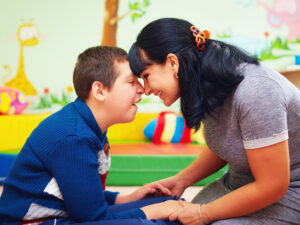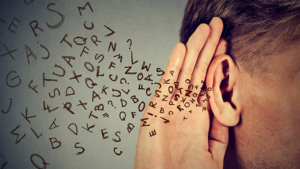To Book an Appointment
SPEECH & LANGUAGE THERAPY
- Articulation therapy
- Fluency therapy
- Swallowing
- Aphasia
- Apraxia
- Dysarthria
- Autism
- Hearing Impairment
- Voice therapy

Articulation therapy or speech sound therapy is working on the placement of articulators (lips, tongue) inside of their mouth to correctly produce their sounds. To master these sounds, speech language pathologists will break down sounds into 7 different levels.
- Isolation Level: If possible, without adding a vowel, your child will work on producing the correct sound in isolation.
- Syllable Level: At this stage we add vowels either before or after the sound to practice making the target sound (ex. ko, koo, kay, key, ki). This helps them put their articulators in the correct placement making the correct sound.
- Word Level: Here the target sound is introduced in single words at the beginning, middle, and end of the word.
- Phrase Level: Now that your child has mastered the target sounds in words we add a few words together including a word that contains the target sound in the beginning, middle, and/or end (ex. the black cat).
- Sentence Level: Here the target sound will be addressed in grammatically correct sentences.
- Reading Level: Speech language pathologists may skip this level. Usually this level is addressed when the child is having difficulty carrying over their skill from the sentence level to conversation.
- Conversation Level: At this stage your child has almost mastered the target sound.

There are different ways to help with stuttering. A treatment team usually includes you, your child, other family members, and your child's teacher. Treatment will depend on one or more of the following:
- How much your child stutters
- How your child reacts when stuttering
- How stuttering impacts your child's everyday life
- How others react to your child when they stutter
- Your child's age

Swallowing happens in three stages, or phases. You can have a problem in one or more of these phases. They include:
- Oral phase – sucking, chewing, and moving food or liquid into the throat.
- Pharyngeal phase – starting the swallow and squeezing food down the throat. You need to close off your airway to keep food or liquid out. Food going into the airway can cause coughing and choking.
- Esophageal phase – opening and closing the esophagus, or the tube that goes from the mouth to the stomach. The esophagus squeezes food down to the stomach. Food can get stuck in the esophagus. Or, you may throw up a lot if there is a problem with your esophagus.

Aphasia is an impairment of language, affecting the production or comprehension of speech and the ability to read or write. Aphasia is always due to injury to the brain-most commonly from a stroke, particularly in older individuals. But brain injuries resulting in aphasia may also arise from head trauma, from brain tumors, or from infections.
Aphasia can be so severe as to make communication with the patient almost impossible, or it can be very mild. It may affect mainly a single aspect of language use, such as the ability to retrieve the names of objects, or the ability to put words together into sentences, or the ability to read. More commonly, however, multiple aspects of communication are impaired, while some channels remain accessible for a limited exchange of information.

Apraxia is a poorly understood neurological condition. People who have it find it difficult or impossible to make certain motor movements, even though their muscles are normal. Milder forms of apraxia are known as dyspraxia.
Apraxia can occur in a number of different forms. One form is orofacial apraxia. People with orofacial apraxia are unable to voluntarily perform certain movements involving facial muscles. For instance, they may not be able to lick their lips or wink. Another form of apraxia affects a person's ability to intentionally move arms and legs.
With apraxia of speech a person finds it difficult or impossible to move their mouth and tongue to speak. This happens, even though the person has the desire to speak and the mouth and tongue muscles are physically able to form words.

We use many muscles to talk. These include muscles in our face, lips, tongue, and throat, as well as muscles for breathing. It is harder to talk when these muscles are weak. Dysarthria happens when you have weak muscles due to brain damage. It is a motor speech disorder and can be mild or severe.
Dysarthria can happen with other speech and language problems. You might have trouble getting messages from your brain to your muscles to make them move, called apraxia. You could also have trouble understanding what others say or telling others about your thoughts, called aphasia.

Autism spectrum disorder (ASD) is a broad term used to describe a group of neurodevelopmental disorders.
These disorders are characterized by problems with communication and social interaction. People with ASD often demonstrate restricted, repetitive, and stereotyped interests or patterns of behavior.
There are no “cures” for autism, but therapies and other treatment considerations can help people feel better or alleviate their symptoms.
Many treatment approaches involve therapies such as:
- behavioral therapy
- play therapy
- occupational therapy
- physical therapy
- speech therapy

Hearing impairment occurs when there's a problem with or damage to one or more parts of the ear.
The degree of hearing impairment can vary widely from person to person. Some people have partial hearing loss, meaning that the ear can pick up some sounds; others have complete hearing loss, meaning that the ear cannot hear at all (people with complete hearing loss are considered deaf). In some types of hearing loss, a person can have much more trouble when there is background noise. One or both ears may be affected, and the impairment may be worse in one ear than in the other.

The aim of voice therapy is to eliminate or improve problems with the creation of vocal sounds (phonation) in the larynx (voice box). After completing therapy, your voice should be stronger and sound like it did before. Voice therapy can also be used for prevention, to train your voice in order to avoid such problems altogether.
Voice therapy includes various individually tailored exercises that can be learned from a speech therapist, voice coach or respiratory therapist. In Germany, statutory health insurers typically cover the costs of voice therapy if it is necessary and has been prescribed by a family doctor or an ENT specialist.
Speech & Language Therapy
Articulation Therapy

Articulation therapy or speech sound therapy is working on the placement of articulators (lips, tongue) inside of their mouth to correctly produce their sounds. To master these sounds, speech language pathologists will break down sounds into 7 different levels.
Fluency Therapy

There are different ways to help with stuttering. A treatment team usually includes you, your child, other family members, and your child’s teacher. Treatment will depend on one or more factors.
Swallowing

Swallowing happens in three stages, or phases. You can have a problem in one or more of these phases. They include:
- Oral phase
- Pharyngeal phase
- Esophageal phase
Aphasia

Aphasia is an impairment of language, affecting the production or comprehension of speech and the ability to read or write. Aphasia is always due to injury to the brain-most commonly from a stroke, particularly in older individuals. But brain injuries resulting in aphasia may also arise from head trauma, from brain tumors, or from infections.
Apraxia

Apraxia is a poorly understood neurological condition. People who have it find it difficult or impossible to make certain motor movements, even though their muscles are normal. Milder forms of apraxia are known as dyspraxia.
Dysarthria

We use many muscles to talk. These include muscles in our face, lips, tongue, and throat, as well as muscles for breathing. It is harder to talk when these muscles are weak. Dysarthria happens when you have weak muscles due to brain damage. It is a motor speech disorder and can be mild or severe.
Autism

Autism spectrum disorder (ASD) is a broad term used to describe a group of neurodevelopmental disorders. These disorders are characterized by problems with communication and social interaction. People with ASD often demonstrate restricted, repetitive, and stereotyped interests or patterns of behavior.
Hearing Impairment

Hearing impairment occurs when there’s a problem with or damage to one or more parts of the ear.
The degree of hearing impairment can vary widely from person to person. Some people have partial hearing loss, meaning that the ear can pick up some sounds; others have complete hearing loss, meaning that the ear cannot hear at all.
Voice Therapy

The aim of voice therapy is to eliminate or improve problems with the creation of vocal sounds (phonation) in the larynx (voice box). After completing therapy, your voice should be stronger and sound like it did before. Voice therapy can also be used for prevention, to train your voice in order to avoid such problems altogether.
